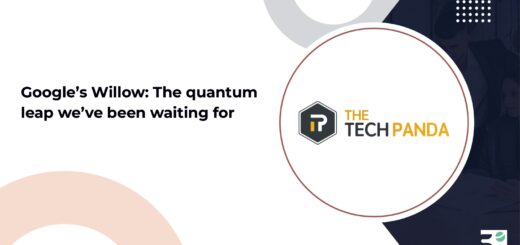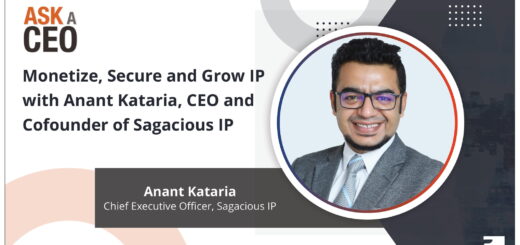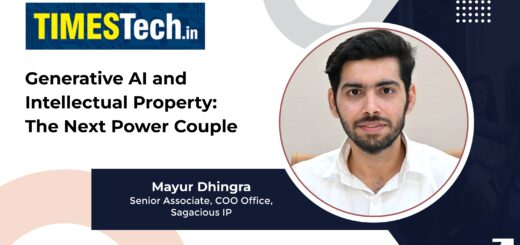IoT For All – IoT Patenting Made Simpler
IoT has changed the way we work and how we interact with technology. Using novel IoT devices such as Amazon Echo or wearables like the FitBit, we’ve turned our humble abodes into smart homes. With the number of IoT devices reaching 8.4 billion alone in 2017, it is estimated that there will be around 29 billion IoT devices by 2022. Thereby increasing the estimated global market value of IoT to $2,488 billion by 2022.With IoT expected to continue growing, businesses are aggressively pursuing patent protection––setting up the future with varied patent disputes down the line.Click To Tweet
Such growth predictions for IoT has got businesses aggressively pursuing patent protection––setting up the future with varied patent disputes down the line.
Table of Contents
Patent Drafting Challenges in IoT: Proven Strategies and Solutions
If you’re a tech company developing IoT technologies, there are specific patent challenges which we will reflect on here and provide solutions for you:
Challenge #1: Claim Scope
IoT systems are diverse with different sorts of devices that collectively perform a specific task. As a result, different ways in which the same invention can be claimed in a patent application. For example:
- Device or apparatus claims cover the IoT device itself (e.g., components controlled by a controller/processor).
- Method claims that cover the way the IoT device operates/functions.
- Method claims that cover the way IoT devices communicate with each other or with other devices (e.g., routers, servers).
- Software-styled claims that cover the software-implemented processes performed by the IoT device.
- Software-styled claims that cover processes performed by a remote server (e.g., “in the cloud”) communicate with the IoT device.
- System-level claims cover multiple IoT devices interacting with each other (e.g., watch and phone; hub and beacons; router and WiFi devices).
However, most patent applications may be limited to two to four independent claims due to the high cost involved.
Solutions
Keeping in mind patentability requirements, cost of obtaining the patent, and value proposition from the invention, we suggest the following approach to address the aforesaid trade-offs:
Solution 1
To figure out the best type of claim for each innovation, consider the following factors:
- What is the business model of the company?
Sellers of the actual IoT device should prioritize device claims and method claims that cover how the device operates. If the company only sells software, software-style claims can be prioritized. If the company is a backend service provider, the server-side “in the cloud” processes can be prioritized.
- Where does the point of novelty lie?
If the invention deals with how the IoT device operates, it might not be possible to have a viable claim for server-side functionality. If the invention is software-implemented, consider software-styled claims.
- What is the relative licensing value for each type of claim?
It might be possible to license a software claim across multiple industries (e.g., for operation on multiple different types of devices).
- Who is the potential infringer?
The general rule of thumb is to choose a claim that you can assert against your competitor (as opposed to your customer or end-users).
Solution 2: Accounting for unexpected prior art(s):
Because there’s a huge amount of innovation in the IoT space right now, it’s possible that during patent prosecution, the invention might encounter prior art that’s currently unknown (e.g., unpublished patent applications). Therefore, the claim strategy should take this into account. For example, several backup positions can be built, either as dependent claims or in the specification. First, a focused claim set can be relied upon, and broader claims can then be pursued in a continued application.
Challenge #2: Joint/Divided Infringement
IoT technology is interactive and often implemented by system components in multiple locations, and as such, an inventor could end up with more than one party infringing the patent rights. The various components that create the IoT system could be sold, owned, and operated by different companies.
Divided infringement deals with whether there can be infringement liability when the infringement is split among multiple parties, actors, or devices.
Although the current rule, established in Akamai v. Limelight, is that there may be infringement liability when the steps of a method are performed by multiple parties, if a single defendant “exercises ‘control or direction’ over the entire process such that every step is attributable to the controlling party,” it becomes a really high bar to meet.
Solutions
Typically, the issues of divided infringement can be overcome by carefully drafting claims from the perspective of only one device in the IoT system. However, drafting that type of claim may only be possible depending on the state-of-the-art and whether the invention is even patent-eligible. If that’s the case, it should instead be preferred to claim the components that would most likely be sold or operated by the competitors. An exemplary case of divided infringement in IoT domain is discussed next:
Smart City
For a real-life example that shows how the various claim strategies overcome joint infringement, we can look into smart city schemes.
Broadly, “sensing cities” use smart sensors as municipal infrastructure. In patenting the sensing city, one could claim:
- The smart sensor itself. However, that likely wouldn’t capture the big picture idea of how it’s being used. And the smart sensor by itself might not be novel, and therefore not patentable.
- The “cloud” perspective (which describes how the data from the sensors is used). However, it might be much more difficult to detect infringement, because you’re basically claiming a software process running on a private server.
- The entire system (which covers the sensors and the servers operating together). However, you might end up with a divided infringement problem where one entity owns or operates the sensors, and another entity aggregates or processes the data.
Sometimes overcoming this problem may require compromise — maybe you simply can’t claim the invention from the perspective of a single device. However, in most cases, a smart drafter can find a way to craft independent claims that don’t have a divided infringement problem, and that’s usually a strong approach.
Challenge #3: Subject-Matter Eligibility Post Alice v CLS Bank Decision:
Patenting inventions directed to the IoT domain has become more challenging in wake of the Alice decision. The following explains the scenario in detail. IoT broadly involves convergence of many technologies, the chief among them being:
- Real time analytics [big data algorithms]
- Machine learning [deep learning algorithms]
- Commodity Sensors [generic]
- Embedded systems [well known technology]
Essentially, IoT employs the above-mentioned technologies in their current state of art and does not intend to induce improvement in their functioning. IoT enables the aforesaid technologies to connect and exchange data (speak with each other), thereby creating opportunities for more direct integration of the physical world into the computer-based systems. This results in efficiency improvements, economic benefits, and reduced human exertions.
Since the underlying objective of IoT ecosystems is concerned with achieving economic benefits and process optimizations, there is a high chance of an invention directed to IoT being characterized as an abstract idea without producing any technical improvement/tangible result.
Solutions
In wake of the recent decisions concerning patent eligibility, there is a need for strategic application drafting for IoT inventions. The foregoing need becomes obvious in view of the following case laws:
Alice Two-Part Test
- laws of nature, natural phenomena, and abstract ideas are not patent eligible.
- Determine a.) if there is an abstract idea in the claim/is the claim directed to an abstract idea? b.) If answer to a.) is yes, whether the additional elements recited in the claim transform the nature of the claim into a patent eligible application.
Diamond v Diehr
- Although the claim may encompass a mathematical formula, if it “implements or applies that formula in a structure or process, which when considered as a whole, is performing a function which patent laws are designed to protect”, the claim is patent eligible.
- The claims in Diehr were directed towards an improvement in the existing technological process.
While Alice set forth a glimpse of how to determine patent eligibility, an older decision in Diehr clearly indicates the underlying principle behind the determination of patent eligibility. For IoT inventions, the closer to Diehr that the patent application can recite the IoT invention and narrowly tailor the claim features that provide a practical application (preferably a real world application) for the invention, the higher is the likelihood of obtaining the patent and withstanding the AIA post grant eligibility challenges.
An exemplary patent eligible case that fits best for IoT ecosystems is Thales Visionix vs. United States:
Brief Overview
The invention was broadly directed towards a helmet mounted display (HMD) used by F-35 fighter pilots. The system utilized a pair of identical sensors arranged as – one mounted on a helmet, the other mounted on an airplane – to determine the orientation of the helmet relative to the moving airplane.
Description of the Problem
During flights, HMDs are subject to drift, in which even small measurement errors can accumulate into larger errors when estimating an object’s position.
Visionix’s Solution
The claimed solution uses a computer running a mathematical equation to periodically calculate the relative orientation of the helmet. At this point, the following observations regarding Visionix’s solution should be paid attention to:
No improvement to the claimed computer that executes the steps. The identical sensors were conventional/generic ones. However, the claimed elements (though generic in nature) operate together to achieve a particular goal.
The claims “result in a system that reduces errors in an inertial system that tracks an objection on a moving platform”, “eliminates many complications” of prior art solutions”, and are thus “unconventional”.
Key Takeaway
Drafting an application for an invention directed towards a non-conventional, specific arrangement of sensors (even though the sensors themselves may be well known), may still provide grounds for patent eligibility.
Another relevant case – Fitbit vs. Jawbone, provides further insights in this regard:
- Improving the human interface for consumer IoT inventions (perhaps because of the apparent real-world application) seems to be persuasive in avoiding/overcoming Alice.
- The interaction of multiple nodes in an IoT ecosystem seems to be another common theme. Furthermore, illustrating the underlying problem, solution story may prove beneficial.
- Considering the small form factor of the claimed IoT devices (wherever applicable), it is imperative to discuss the inherent challenges and how the claimed solution addresses those challenges arising due to small form factor.
Conclusion
The following points give good insights regarding patent eligibility of IoT technology landscape:
- Industrial IoT inventions, if properly claimed, will continue to be patent eligible.
- A new arrangement/combination of generic IoT elements directed towards solving an old standing problem will remain patent eligible.
- Drafting the claims in a manner that addresses a technology centric problem, can be found persuasive while ascertaining patent eligibility of the claimed subject matter.
A list of software styled patents which were found to be eligible by the US courts and which are relevant to the IoT ecosystem can be found here.
Challenge #4: Patent Quality
Currently, a lot of tech companies are just stockpiling patents — but a lot of these patents do not contain strong claims, meaning that they either don’t cover anything valuable (because the claims are too narrow) or would be vulnerable to prior art challenges in, say, IPR proceedings (because the claims are overly broad or nebulous).
But as the patent office and district courts continue to sort through the mess created by the Alice decision, it’s likely that the quality of IoT patents will improve as more companies start putting a stronger emphasis on drafting robust patent applications that will hold up under close scrutiny.
Solution
The sole purpose of obtaining a patent on an IoT invention may be to protect the interests of the inventor(s) pertaining to what the inventor(s) may regard as the invention. In this regard, it may be important to focus on quality patents that are enforceable. Drafting patent applications that are way too narrow may lead to patents that may not be enforceable and should be avoided at all cost.
Specifically, by narrow applications, we mean undue limiting of the claims and embodiments beyond the point of novelty. Features that do not contribute to the absolute novelty should be recited at a broader level. Similarly, features other than those which bring out the ‘significantly more’ aspect of the invention, should be accorded their broadest possible scope. Of course, they can be identified with examples in the specification to provide enablement.
Another important aspect that may improve the quality of the patent would be drafting focused dependent claims. The prime importance of dependent claims emerges from the fact that the dependent claims act as back up claims for the independent claims. Accordingly, this objective should be prioritized over all other priorities of dependent claims. In as much as possible, features that form part of prior arts, especially obvious to combine features should not be preferred over important aspects of the invention that may narrow down one or more features of the independent claim.
In conclusion, we propose an approach that is centered on drafting realistically broad claims (with high infringement potential) and one that addresses the aforesaid challenges.
Originally published on: https://www.iotforall.com/iot-patenting-made-simpler




